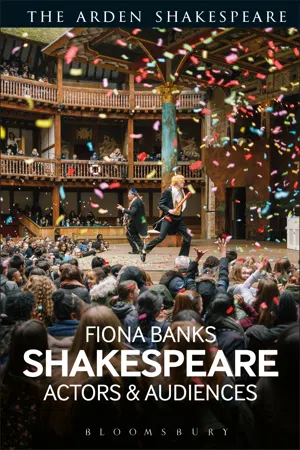![]()
PART ONE
Actor and Audience: A Theoretical Framework
![]()
1
Who Are We Talking About When We Talk About ‘the Audience’?
Stephen Purcell
Reflecting on the reconstructed Globe’s Prologue Season in 1996, the theatre’s then-new artistic director Mark Rylance recounted a story of the final scene of The Two Gentlemen of Verona, in which he had played Proteus:
When Valentine asked Julia to forgive me and take me back, the audience shouted out – ‘Don’t do it, Julia!’ And I’m thinking – ‘My God, if she doesn’t have me back, this is what it feels like to have a mob around you who might take justice into their own hands!’ So my pleading as a character was greatly motivated! And she took me back as she never had before, in defiance of their merciless justice. In that way the audience is shaping the narrative.1
Indeed, one of the discoveries Rylance and his company made during this and subsequent seasons at the Globe was the tremendous power the audience had in an open-air playhouse of this sort. But who, precisely, was Rylance talking about here? When he claimed that ‘the audience’ called out ‘Don’t do it, Julia!’, he was of course exaggerating; in Globe research fellow Pauline Kiernan’s account of the same performance, she recalls a single ‘loud, clear, heartfelt voice’ from the gallery shouting the phrase. She, too, records this as a moment at which the playing of this scene was altered ‘by public demand – literally’.2 According to Kiernan, actress Stephanie Roth, who played Julia, ‘changed the way she played the scene’ after this, acknowledging ‘the pain and guilt, the humiliation and remorse that had gone before’, and developing ‘a complex, poignant moment, rather than a simplistic, comic one’.3 In Rylance’s anecdote, the audience response prompted a live counter-response from the actors, shifting the meaning of the scene in the moment of playing it; in Kiernan’s, it provoked reflection on the part of the actors and a permanent alteration to the production. Given the evident significance of this particular audience interjection, it is fascinating to read a third account of it, in which another observer heard the outburst differently: in David Nathan’s review for the Jewish Chronicle, ‘a groundling shouts, “Go to it Julia,” as Stephanie Roth’s innocent heroine is urged to forgive’, and Nathan wonders whether this response had been ‘sought by director Jack Shepherd’.4 In Nathan’s account, the interjection comes not only from a different part of the theatre (the yard rather than the gallery), but carries almost the opposite meaning: ‘Go to it’ suggests encouragement rather than the hostility to Proteus sensed by Rylance.
This chapter aims to give an overview of some of the ways in which notions of ‘the audience’ are constructed by Shakespearean plays in performance. I begin with this story because it indicates some of the slipperiness that inevitably surrounds discussions of ‘the audience’. We have the elision of a single voice with a collective identity (‘a mob’), in which the response of a lone spectator comes to stand for that of the whole crowd (which may, of course, have actually contained spectators with all kinds of different feelings about Proteus and Julia’s reunion). We have a sense of the ways in which audience response can provide a very influential kind of feedback to performers, both in the moment of performance and for the duration of a whole run. We have the idea that particular audience reactions can deliberately be ‘sought’ by a production. We have the notion that audience activity can go beyond mere ‘response’ and become an active part of the performance. We have an example of an audience reaction that in turn provoked other spectator responses. And, finally, we have an illustration of the ultimate unreadability of audience response, which in both the moment of performance and in subsequent accounts can be interpreted in different, even polarized ways.
There is, or rather was, an audience anticipated within the text of each of Shakespeare’s plays. This audience was historical and more or less specific. The plays were probably composed with more than one type of audience in mind: Shakespeare must have written some of them with the reasonable expectation that they might be performed before relatively diverse popular audiences at open-air ‘public’ theatres like the Globe, regional audiences on tour, more exclusive audiences at indoor ‘private’ theatres like the Blackfriars, and elite audiences at the court.5 These audiences are, of course, lost to time: when a modern audience of Twelfth Night hears that Malvolio ‘does smile his face into more lines than is in the new map with the augmentation of the Indies’ (3.2.74–6), for example, they may get an impression of the grotesque sight being described, but are unlikely to spot what an Elizabethan audience would probably have recognized as a reference to Edward Wright’s 1600 Map of the World.6 Likewise, when the same character is described as ‘a kind of Puritan’ (2.3.136), modern spectators may understand what is meant, but we cannot share in the currency this kind of charge must have had for a group of people watching a play in a society in which theatre and Puritanism were so fundamentally at odds. It is important to remember, then, that the audiences imagined by the texts may be broad and loosely defined, but they are certainly not us.
But texts are not merely reactive to an existing audience. In some ways, they also create the audience – or at least they shape it, through the way in which they address the imagined group. The most obvious moments in which Shakespeare’s plays do this are the prologues, epilogues and chorus speeches where an audience is directly and unambiguously addressed. Six of Shakespeare’s plays are bookended with speeches of this sort;7 a f...
